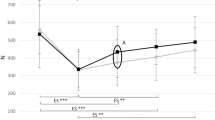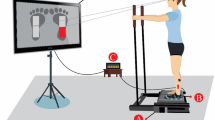Abstract
Voluntary arm movements are preceded by dynamical and electromyographical (EMG) phenomena in “postural segments” (i.e. body segments not directly involved in the voluntary movement) called “anticipatory postural adjustments” (APA). The present study examined how the central nervous system organizes APA under fatigued state of postural musculature elicited by series of high-level isometric contractions (HIC), i.e. corresponding to 60% of maximal voluntary contraction. Subjects (N = 14) purposely performed series of bilateral-forward reach task (BFR) under unipodal stance (dominant and non-dominant) before (“no fatigue” condition, NF) and after (“fatigue” condition, F) a procedure designed to obtain major fatigue in hamstrings. Centre-of-gravity acceleration, centre-of-pressure displacement, and electrical activity of trunk and leg muscles were recorded and quantified within a time-window typical of APA. Results showed that there was no significant effect of fatigue on the level of muscle excitation and APA onset in any of the postural muscles recorded. Similarly, no change in APA onset could be detected from the biomechanical traces. In contrast, results showed that the amplitude of anticipatory centre-of-pressure displacement and centre-of-gravity acceleration reached lower value in F than in NF. Similar results were obtained whether dominant or non-dominant leg was considered. The changes in biomechanical APA features could not be ascribed to a different focal movement performance (maximal BFR velocity and acceleration) between F and NF. These results suggest that, when fatigue is induced by HIC, the capacity of the central nervous system to adapt APA programming to the fatigued state of the postural muscle system might be altered.





Similar content being viewed by others
References
Belenkii VE, Gurfinkel VS, Paltsev EI (1967) On elements of control of voluntary movements. Biofizika 12:135–141
Bongiovanni LG, Hagbarth KE (1990) Tonic vibration reflexes elicited during fatigue from maximal voluntary contractions in man. J Physiol 423:1–14
Bonnetblanc F, Martin O, Teasdale N (2004) Pointing to a target from an upright standing position: anticipatory postural adjustments are modulated by the size of the target in humans. Neurosci Lett 358:181–184
Bouisset S (1991) Relationship between postural support and intentional movement: biomechanical approach. Arch Int Physiol Biochim Biophys 99:A77–A92
Bouisset S, Do MC (2008) Posture, dynamic stability, and voluntary movement. Clin Neurophysiol 38:345–362
Bouisset S, Zattara M (1987) Biomechanical study of the programming of anticipatory postural adjustments associated with voluntary movement. J Biomech 20:735–742
Brenière Y, Do MC, Bouisset S (1987) Are dynamic phenomena prior to stepping essential to walking? J Mot Behav 19:62–76
Cordo PJ, Nashner LM (1982) Properties of postural adjustments associated with rapid arm movements. J Neurophysiol 47:287–302
Duchateau J, Hainaut K (1985) Electrical and mechanical failures during sustained and intermittent contractions in humans. J Appl Physiol 58:942–947
Edwards RG, Lippold OCJ (1953) The relation between force and integrated electrical activity in fatigued muscle. J Physiol 132:677–681
Fukami Y (1988) The effects of NH3 and CO2 on the sensory ending of mammalian muscle spindles: intracellular pH as a possible mechanism. Brain Res 463:140–143
Gurfinkel VS, Levik YuS, Popov KE, Smertanin BN, Shlikov VYu (1988) Body scheme in the control of postural activity. In: Gurfinkel VS, Loffe ME, Massion J, Roll JP (eds) Stance and motion, facts and concepts. Plenum Press, New York, pp 185–193
Henneman E, Somjen G, Carpenter DO (1965) Functional significance of cell size in spinal motoneurons. J Neurophysiol 28:560–580
Hoffman M, Schrader J, Applegate T, Koceja D (1998) Unilateral postural control of the functionally dominant and nondominant extremities of healthy subjects. J Athl Train 33:319–322
Kanekar N, Santos MJ, Aruin AS (2008) Anticipatory postural control following fatigue of postural and focal muscles. Clin Neurophysiol 119:2304–2313
Ljubisavljević M, Anastasijević R (1996) Fusimotor system in muscle fatigue. J Peripher Nerv Syst 1:83–96
Massion J (1992) Movement, posture and equilibrium: interaction and coordination. Prog Neurobiol 38:35–36
Mezaour M, Yiou E, Le Bozec S (2009) Does symmetrical upper limb task involve symmetrical postural adjustments? Gait Posture 30:239–244
Morris SL, Allison GT (2006) Effects of abdominal muscle fatigue on anticipatory postural adjustments associated with arm raising. Gait Posture 24:342–348
Pedersen J, Ljubisavljevic M, Bergenheim M, Johansson H (1998) Alterations in information transmission in ensembles of primary muscle spindle afferents after muscle fatigue in heteronymous muscle. Neuroscience 84:953–959
Ruget H, Blouin J, Teasdale N, Mouchnino L (2008) Can prepared anticipatory postural adjustments be updated by proprioception? Neuroscience 155:640–648
Schenau GJVI, Dorssers WM, Welter TG, Beelen A, de Groot G, Jacobs R (1995) The control of monoarticular muscles in multijoint leg extensions in man. J Physiol 484(Pt 1):247–254
Shiratori T, Latash M (2000) The roles of proximal and distal muscles in anticipatory postural adjustments under asymetrical perturbations and during standing on rollerskates. Clin Neurophysiol 111:613–623
Strang AJ, Berg WP (2007) Fatigue-induced adaptive changes of anticipatory postural adjustments. Exp Brain Res 178:49–61
Strang AJ, Choi HJ, Berg WP (2008) The effect of exhausting aerobic exercise on the timing of anticipatory postural adjustments. J Sports Med Phys Fit 48:9–16
Taylor JL, Butler JE, Gandevia SC (2000) Changes in muscle afferents, motoneurons and motor drive during muscle fatigue. Eur J Appl Physiol 83:106–115
Vuillerme N, Nougier V, Teasdale N (2002) Effects of lower limbs muscular fatigue on anticipatory postural adjustments during arm motions in humans. J Sports Med Phys Fit 42:289–294
Wilmore JH, Costill DL (1999) Physiology of sport and exercise. Human Kinetics, Champaign, IL
Yiou E, Hamaoui A, Le Bozec S (2007) Influence of base of support size on arm pointing performance and associated anticipatory postural adjustments. Neurosci Lett 423:29–34
Yiou E, Heugas AM, Mezaour M, Le Bozec S (2009a) Effect of lower limb muscle fatigue induced by high-level isometric contractions on postural maintenance and postural adjustments associated with bilateral forward-reach task. Gait Posture 29:97–101
Yiou E, Mezaour M, Le Bozec S (2009b) Anticipatory postural adjustments and focal performance during bilateral forward-reach task under different stance conditions. Mot Control 13:142–160
Zattara M, Bouisset S (1986) Chronometric analysis of the posturo-kinetic programming of voluntary movement. J Mot Behav 18:215–223
Zhang LQ, Rymer WZ (2001) Reflex and intrinsic changes induced by fatigue of human elbow extensor muscles. J Neurophysiol 86:1086–1094
Author information
Authors and Affiliations
Corresponding author
Additional information
Communicated by Jaap van Dieen.
Rights and permissions
About this article
Cite this article
Mezaour, M., Yiou, E. & Le Bozec, S. Effect of lower limb muscle fatigue on anticipatory postural adjustments associated with bilateral-forward reach in the unipedal dominant and non-dominant stance. Eur J Appl Physiol 110, 1187–1197 (2010). https://doi.org/10.1007/s00421-010-1595-3
Accepted:
Published:
Issue Date:
DOI: https://doi.org/10.1007/s00421-010-1595-3




